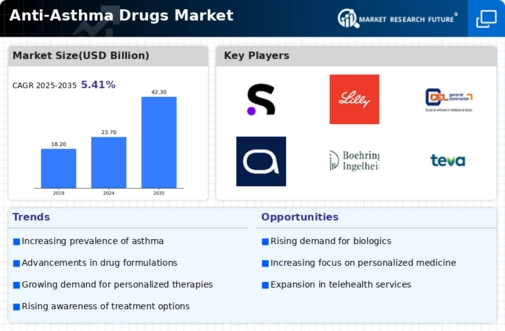Rising Prevalence of Asthma
The increasing prevalence of asthma worldwide is a primary driver for the Anti-Asthma Drugs Market. According to recent estimates, approximately 300 million individuals are affected by asthma, with numbers expected to rise due to urbanization and environmental factors. This growing patient population necessitates the development and availability of effective anti-asthma medications. Furthermore, the rising awareness of asthma management among healthcare professionals and patients contributes to the demand for innovative treatment options. As a result, pharmaceutical companies are investing significantly in research and development to create new therapies, thereby expanding the Anti-Asthma Drugs Market. The focus on improving patient outcomes through effective medication is likely to drive market growth in the coming years.
Growing Awareness and Education
Growing awareness and education regarding asthma management are pivotal in driving the Anti-Asthma Drugs Market. Public health campaigns and educational initiatives by healthcare organizations are increasing knowledge about asthma symptoms, triggers, and treatment options. This heightened awareness encourages patients to seek medical advice and adhere to prescribed therapies, thereby increasing the demand for anti-asthma medications. Furthermore, healthcare professionals are being trained to provide better patient education, which is essential for effective asthma management. As patients become more informed about their condition, they are more likely to utilize available treatments, contributing to the overall growth of the Anti-Asthma Drugs Market. This trend is expected to continue as awareness campaigns evolve and reach broader audiences.
Increased Healthcare Expenditure
Increased healthcare expenditure across various regions is a significant driver for the Anti-Asthma Drugs Market. Governments and private sectors are allocating more resources to healthcare, which includes funding for asthma treatment and management. This trend is particularly evident in developed economies, where healthcare budgets are expanding to accommodate the rising costs associated with chronic diseases like asthma. As a result, patients are gaining better access to essential medications and therapies, leading to higher sales in the Anti-Asthma Drugs Market. Moreover, the emphasis on preventive care and early intervention strategies is likely to further boost the demand for anti-asthma drugs, as healthcare systems aim to reduce long-term healthcare costs associated with uncontrolled asthma.
Advancements in Drug Formulations
Advancements in drug formulations are significantly influencing the Anti-Asthma Drugs Market. The introduction of novel delivery systems, such as inhalers and nebulizers, has enhanced the efficacy and convenience of asthma medications. For instance, dry powder inhalers and soft mist inhalers have gained popularity due to their ease of use and improved drug absorption. Additionally, the development of combination therapies that target multiple pathways in asthma pathophysiology is becoming increasingly common. These innovations not only improve patient adherence but also provide healthcare providers with more effective treatment options. As a result, the market is witnessing a surge in demand for these advanced formulations, which is likely to propel the growth of the Anti-Asthma Drugs Market in the foreseeable future.
Regulatory Support for Drug Approvals
Regulatory support for drug approvals is a crucial factor influencing the Anti-Asthma Drugs Market. Regulatory agencies are increasingly streamlining the approval process for new asthma medications, which facilitates quicker access to innovative therapies for patients. This supportive environment encourages pharmaceutical companies to invest in research and development, leading to a more diverse range of treatment options. Additionally, the introduction of expedited pathways for promising therapies, such as breakthrough designations, is likely to enhance the speed at which new drugs reach the market. As a result, the Anti-Asthma Drugs Market is expected to benefit from a continuous influx of novel medications, ultimately improving patient care and treatment outcomes.


















Leave a Comment